Physics 14: End of Module Exam - Detailed Solutions Provided
VerifiedAdded on 2022/07/28
|16
|1923
|24
Homework Assignment
AI Summary
This document presents a comprehensive solution to a Physics exam, likely for a Physical Sciences module (FC709). The exam covers a wide range of topics, including pressure in interstellar space, magnetic fields, Ohm's law, heat transfer, the photoelectric effect, and atomic physics (Lyman series). The solution includes detailed calculations, explanations of physical principles, and diagrams where appropriate. Section A addresses five questions, while Section B tackles three out of four questions. The student demonstrates an understanding of concepts such as ideal gas laws, electromagnetism, mechanics, and wave phenomena. The solutions are presented in a clear and organized manner, with references to scientific literature. The student's work showcases the application of physics principles to solve complex problems, providing valuable insights into the subject matter.

Running head: PHYSICS 1
Physics
Name
Institution
Physics
Name
Institution
Paraphrase This Document
Need a fresh take? Get an instant paraphrase of this document with our AI Paraphraser
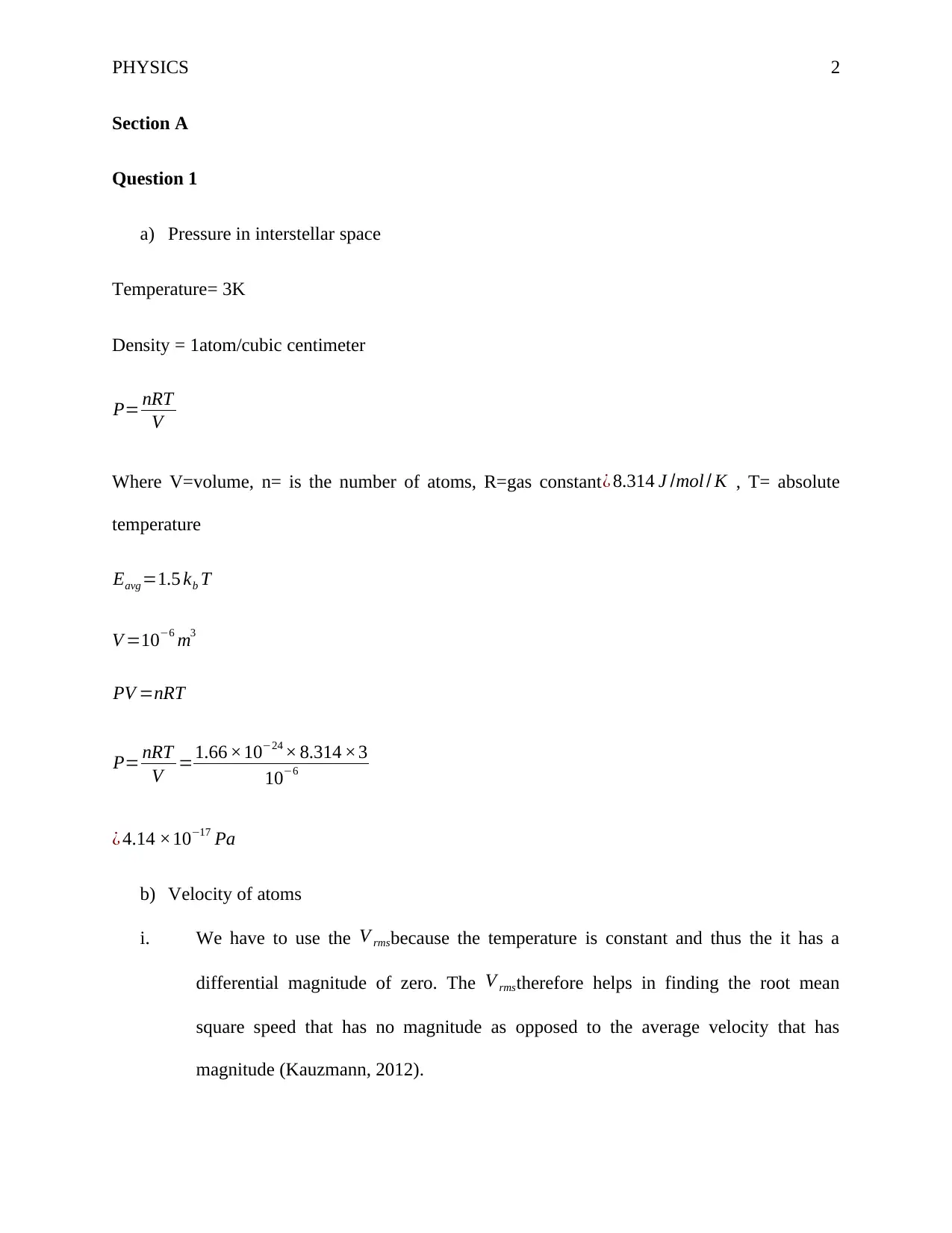
PHYSICS 2
Section A
Question 1
a) Pressure in interstellar space
Temperature= 3K
Density = 1atom/cubic centimeter
P= nRT
V
Where V=volume, n= is the number of atoms, R=gas constant¿ 8.314 J /mol / K , T= absolute
temperature
Eavg =1.5 kb T
V =10−6 m3
PV =nRT
P= nRT
V =1.66 ×10−24 × 8.314 ×3
10−6
¿ 4.14 ×10−17 Pa
b) Velocity of atoms
i. We have to use the V rmsbecause the temperature is constant and thus the it has a
differential magnitude of zero. The V rmstherefore helps in finding the root mean
square speed that has no magnitude as opposed to the average velocity that has
magnitude (Kauzmann, 2012).
Section A
Question 1
a) Pressure in interstellar space
Temperature= 3K
Density = 1atom/cubic centimeter
P= nRT
V
Where V=volume, n= is the number of atoms, R=gas constant¿ 8.314 J /mol / K , T= absolute
temperature
Eavg =1.5 kb T
V =10−6 m3
PV =nRT
P= nRT
V =1.66 ×10−24 × 8.314 ×3
10−6
¿ 4.14 ×10−17 Pa
b) Velocity of atoms
i. We have to use the V rmsbecause the temperature is constant and thus the it has a
differential magnitude of zero. The V rmstherefore helps in finding the root mean
square speed that has no magnitude as opposed to the average velocity that has
magnitude (Kauzmann, 2012).
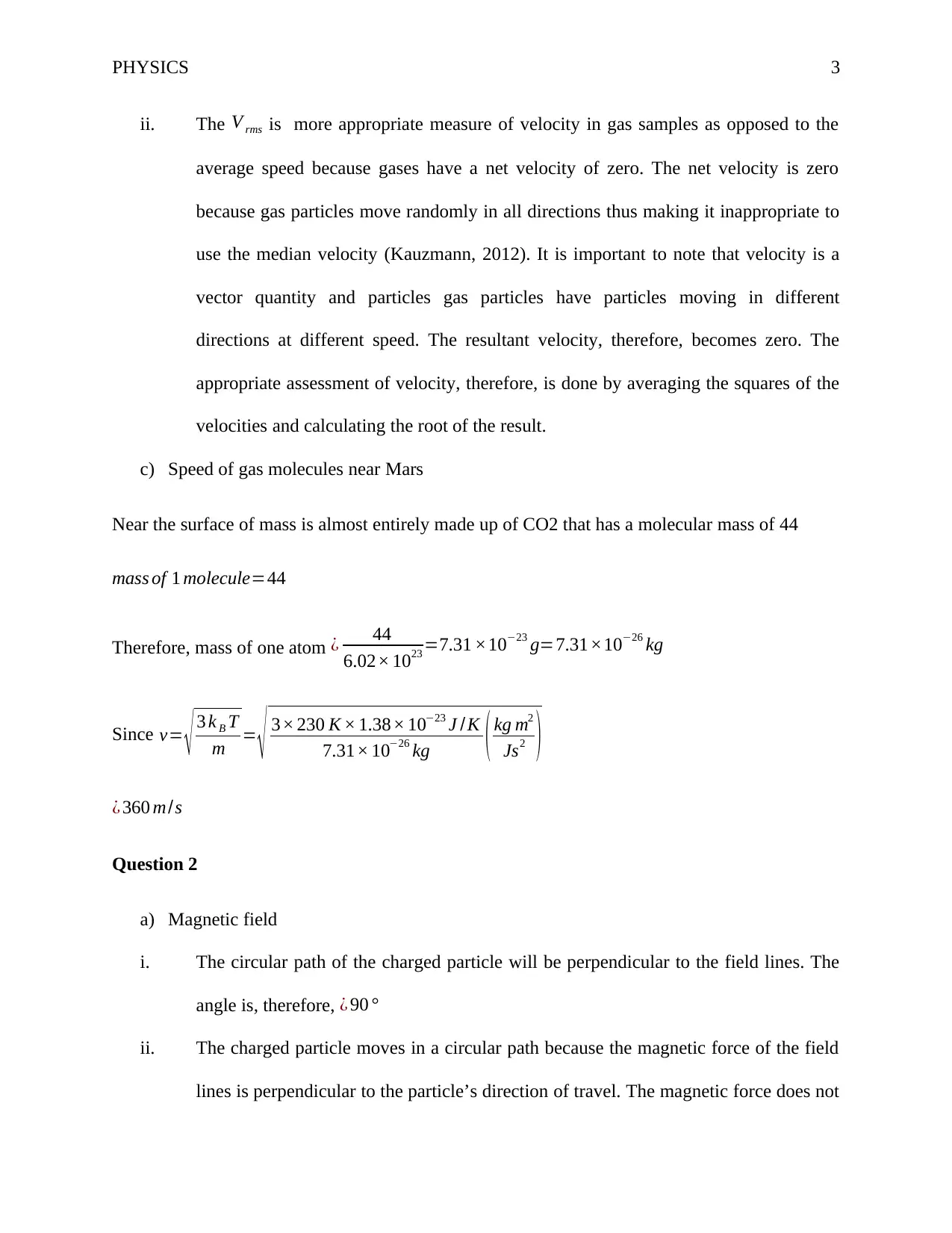
PHYSICS 3
ii. The V rms is more appropriate measure of velocity in gas samples as opposed to the
average speed because gases have a net velocity of zero. The net velocity is zero
because gas particles move randomly in all directions thus making it inappropriate to
use the median velocity (Kauzmann, 2012). It is important to note that velocity is a
vector quantity and particles gas particles have particles moving in different
directions at different speed. The resultant velocity, therefore, becomes zero. The
appropriate assessment of velocity, therefore, is done by averaging the squares of the
velocities and calculating the root of the result.
c) Speed of gas molecules near Mars
Near the surface of mass is almost entirely made up of CO2 that has a molecular mass of 44
mass of 1 molecule=44
Therefore, mass of one atom ¿ 44
6.02× 1023 =7.31 ×10−23 g=7.31×10−26 kg
Since v= √ 3 k B T
m = √ 3× 230 K × 1.38× 10−23 J /K
7.31× 10−26 kg ( kg m2
Js2 )
¿ 360 m/s
Question 2
a) Magnetic field
i. The circular path of the charged particle will be perpendicular to the field lines. The
angle is, therefore, ¿ 90 °
ii. The charged particle moves in a circular path because the magnetic force of the field
lines is perpendicular to the particle’s direction of travel. The magnetic force does not
ii. The V rms is more appropriate measure of velocity in gas samples as opposed to the
average speed because gases have a net velocity of zero. The net velocity is zero
because gas particles move randomly in all directions thus making it inappropriate to
use the median velocity (Kauzmann, 2012). It is important to note that velocity is a
vector quantity and particles gas particles have particles moving in different
directions at different speed. The resultant velocity, therefore, becomes zero. The
appropriate assessment of velocity, therefore, is done by averaging the squares of the
velocities and calculating the root of the result.
c) Speed of gas molecules near Mars
Near the surface of mass is almost entirely made up of CO2 that has a molecular mass of 44
mass of 1 molecule=44
Therefore, mass of one atom ¿ 44
6.02× 1023 =7.31 ×10−23 g=7.31×10−26 kg
Since v= √ 3 k B T
m = √ 3× 230 K × 1.38× 10−23 J /K
7.31× 10−26 kg ( kg m2
Js2 )
¿ 360 m/s
Question 2
a) Magnetic field
i. The circular path of the charged particle will be perpendicular to the field lines. The
angle is, therefore, ¿ 90 °
ii. The charged particle moves in a circular path because the magnetic force of the field
lines is perpendicular to the particle’s direction of travel. The magnetic force does not
⊘ This is a preview!⊘
Do you want full access?
Subscribe today to unlock all pages.

Trusted by 1+ million students worldwide
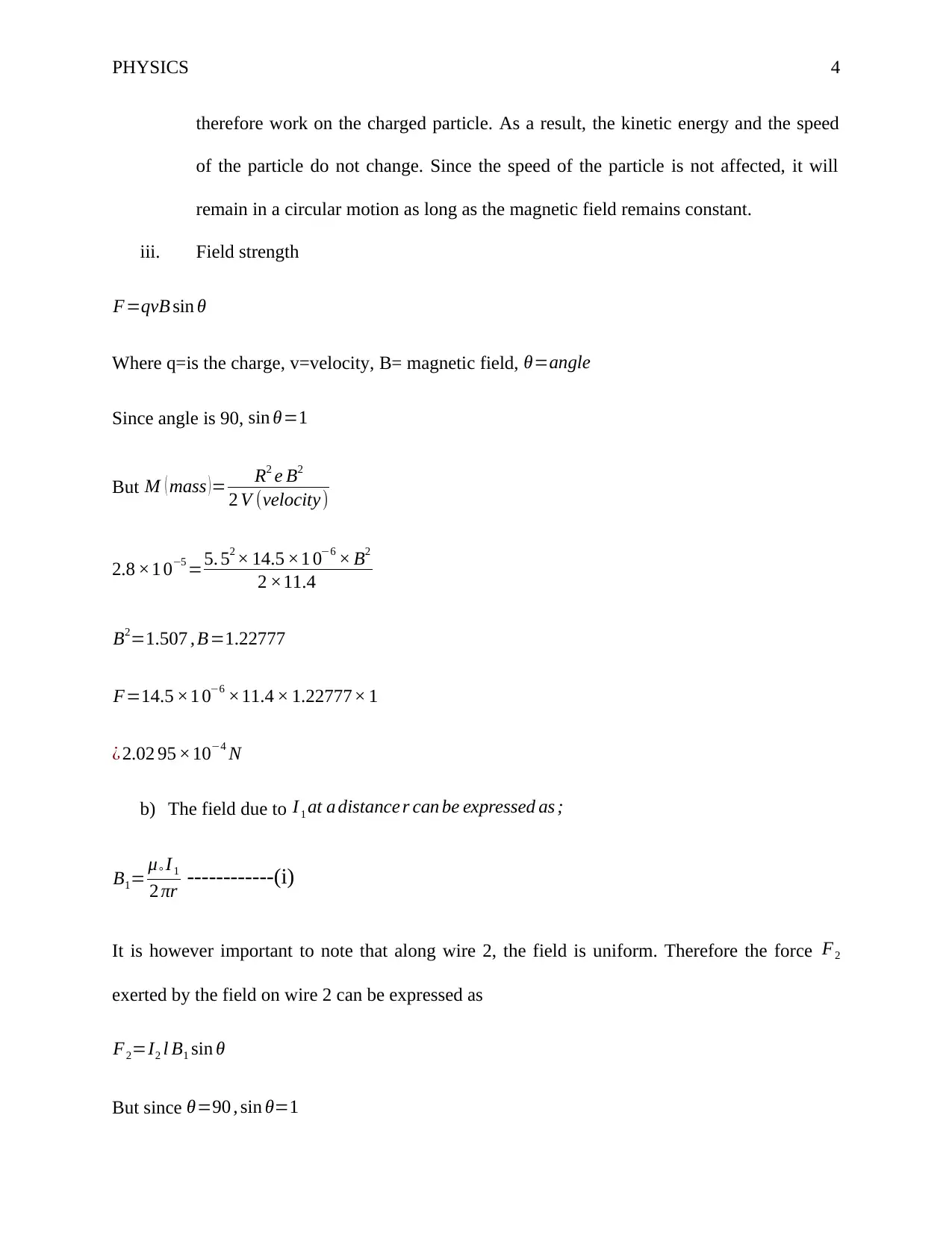
PHYSICS 4
therefore work on the charged particle. As a result, the kinetic energy and the speed
of the particle do not change. Since the speed of the particle is not affected, it will
remain in a circular motion as long as the magnetic field remains constant.
iii. Field strength
F=qvB sin θ
Where q=is the charge, v=velocity, B= magnetic field, θ=angle
Since angle is 90, sin θ=1
But M ( mass )= R2 e B2
2 V (velocity)
2.8 ×1 0−5 =5. 52 × 14.5 ×1 0−6 × B2
2 ×11.4
B2=1.507 , B=1.22777
F=14.5 ×1 0−6 ×11.4 × 1.22777× 1
¿ 2.02 95 ×10−4 N
b) The field due to I1 at a distance r can be expressed as ;
B1= μ° I1
2 πr ------------(i)
It is however important to note that along wire 2, the field is uniform. Therefore the force F2
exerted by the field on wire 2 can be expressed as
F2=I2 l B1 sin θ
But since θ=90 , sin θ=1
therefore work on the charged particle. As a result, the kinetic energy and the speed
of the particle do not change. Since the speed of the particle is not affected, it will
remain in a circular motion as long as the magnetic field remains constant.
iii. Field strength
F=qvB sin θ
Where q=is the charge, v=velocity, B= magnetic field, θ=angle
Since angle is 90, sin θ=1
But M ( mass )= R2 e B2
2 V (velocity)
2.8 ×1 0−5 =5. 52 × 14.5 ×1 0−6 × B2
2 ×11.4
B2=1.507 , B=1.22777
F=14.5 ×1 0−6 ×11.4 × 1.22777× 1
¿ 2.02 95 ×10−4 N
b) The field due to I1 at a distance r can be expressed as ;
B1= μ° I1
2 πr ------------(i)
It is however important to note that along wire 2, the field is uniform. Therefore the force F2
exerted by the field on wire 2 can be expressed as
F2=I2 l B1 sin θ
But since θ=90 , sin θ=1
Paraphrase This Document
Need a fresh take? Get an instant paraphrase of this document with our AI Paraphraser
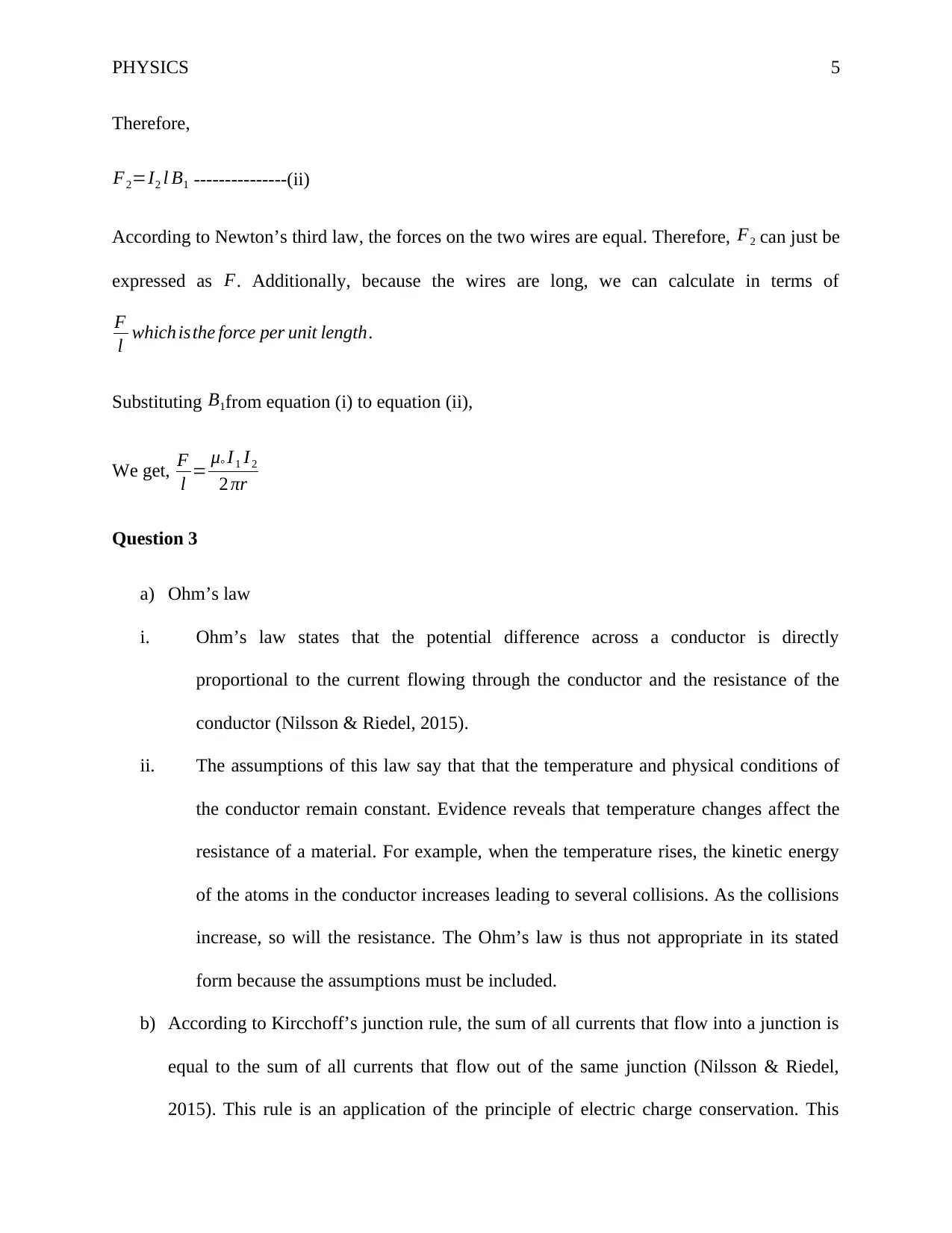
PHYSICS 5
Therefore,
F2=I2 l B1 ---------------(ii)
According to Newton’s third law, the forces on the two wires are equal. Therefore, F2 can just be
expressed as F. Additionally, because the wires are long, we can calculate in terms of
F
l which isthe force per unit length.
Substituting B1from equation (i) to equation (ii),
We get, F
l = μ° I1 I2
2 πr
Question 3
a) Ohm’s law
i. Ohm’s law states that the potential difference across a conductor is directly
proportional to the current flowing through the conductor and the resistance of the
conductor (Nilsson & Riedel, 2015).
ii. The assumptions of this law say that that the temperature and physical conditions of
the conductor remain constant. Evidence reveals that temperature changes affect the
resistance of a material. For example, when the temperature rises, the kinetic energy
of the atoms in the conductor increases leading to several collisions. As the collisions
increase, so will the resistance. The Ohm’s law is thus not appropriate in its stated
form because the assumptions must be included.
b) According to Kircchoff’s junction rule, the sum of all currents that flow into a junction is
equal to the sum of all currents that flow out of the same junction (Nilsson & Riedel,
2015). This rule is an application of the principle of electric charge conservation. This
Therefore,
F2=I2 l B1 ---------------(ii)
According to Newton’s third law, the forces on the two wires are equal. Therefore, F2 can just be
expressed as F. Additionally, because the wires are long, we can calculate in terms of
F
l which isthe force per unit length.
Substituting B1from equation (i) to equation (ii),
We get, F
l = μ° I1 I2
2 πr
Question 3
a) Ohm’s law
i. Ohm’s law states that the potential difference across a conductor is directly
proportional to the current flowing through the conductor and the resistance of the
conductor (Nilsson & Riedel, 2015).
ii. The assumptions of this law say that that the temperature and physical conditions of
the conductor remain constant. Evidence reveals that temperature changes affect the
resistance of a material. For example, when the temperature rises, the kinetic energy
of the atoms in the conductor increases leading to several collisions. As the collisions
increase, so will the resistance. The Ohm’s law is thus not appropriate in its stated
form because the assumptions must be included.
b) According to Kircchoff’s junction rule, the sum of all currents that flow into a junction is
equal to the sum of all currents that flow out of the same junction (Nilsson & Riedel,
2015). This rule is an application of the principle of electric charge conservation. This
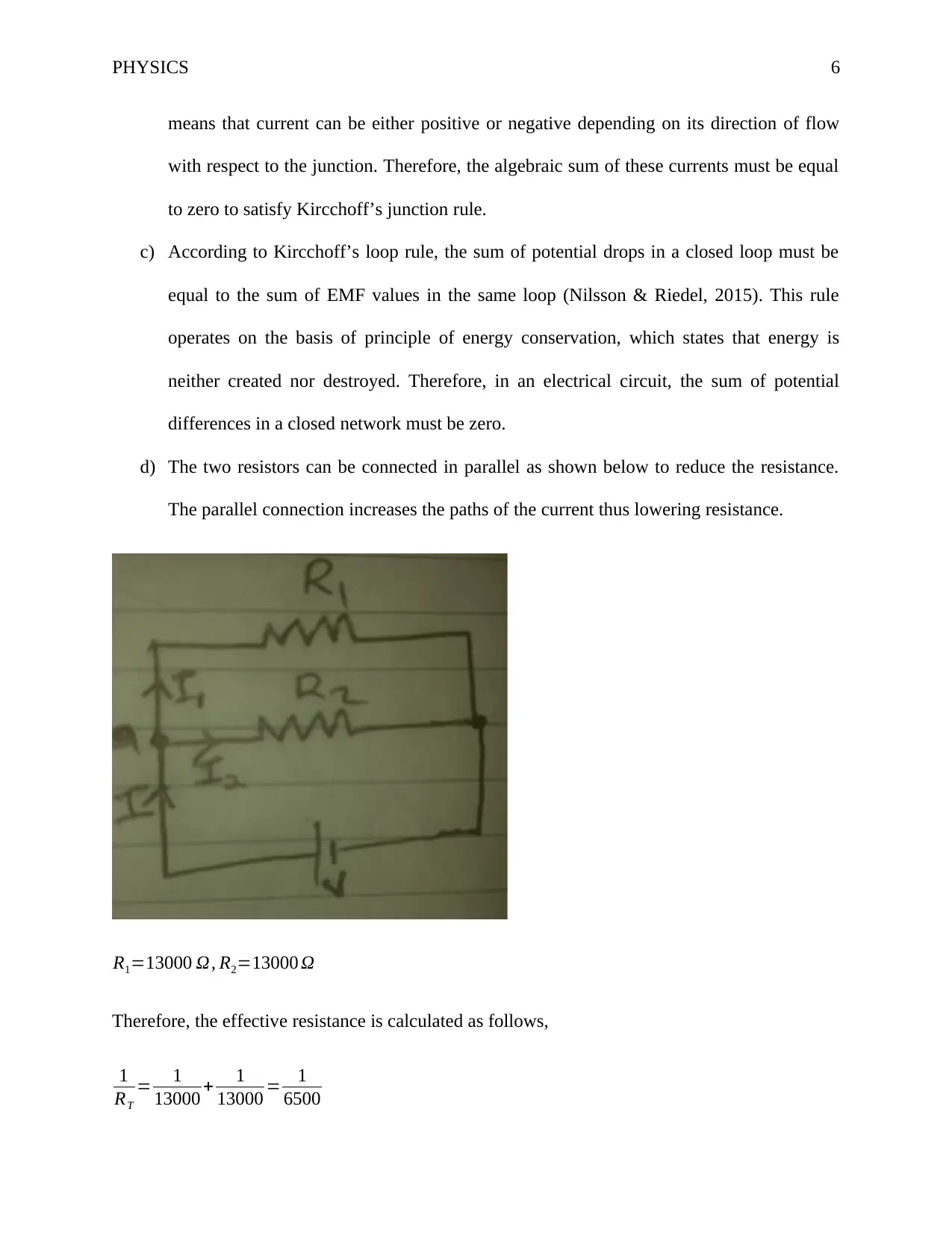
PHYSICS 6
means that current can be either positive or negative depending on its direction of flow
with respect to the junction. Therefore, the algebraic sum of these currents must be equal
to zero to satisfy Kircchoff’s junction rule.
c) According to Kircchoff’s loop rule, the sum of potential drops in a closed loop must be
equal to the sum of EMF values in the same loop (Nilsson & Riedel, 2015). This rule
operates on the basis of principle of energy conservation, which states that energy is
neither created nor destroyed. Therefore, in an electrical circuit, the sum of potential
differences in a closed network must be zero.
d) The two resistors can be connected in parallel as shown below to reduce the resistance.
The parallel connection increases the paths of the current thus lowering resistance.
R1=13000 Ω, R2=13000 Ω
Therefore, the effective resistance is calculated as follows,
1
RT
= 1
13000 + 1
13000 = 1
6500
means that current can be either positive or negative depending on its direction of flow
with respect to the junction. Therefore, the algebraic sum of these currents must be equal
to zero to satisfy Kircchoff’s junction rule.
c) According to Kircchoff’s loop rule, the sum of potential drops in a closed loop must be
equal to the sum of EMF values in the same loop (Nilsson & Riedel, 2015). This rule
operates on the basis of principle of energy conservation, which states that energy is
neither created nor destroyed. Therefore, in an electrical circuit, the sum of potential
differences in a closed network must be zero.
d) The two resistors can be connected in parallel as shown below to reduce the resistance.
The parallel connection increases the paths of the current thus lowering resistance.
R1=13000 Ω, R2=13000 Ω
Therefore, the effective resistance is calculated as follows,
1
RT
= 1
13000 + 1
13000 = 1
6500
⊘ This is a preview!⊘
Do you want full access?
Subscribe today to unlock all pages.

Trusted by 1+ million students worldwide
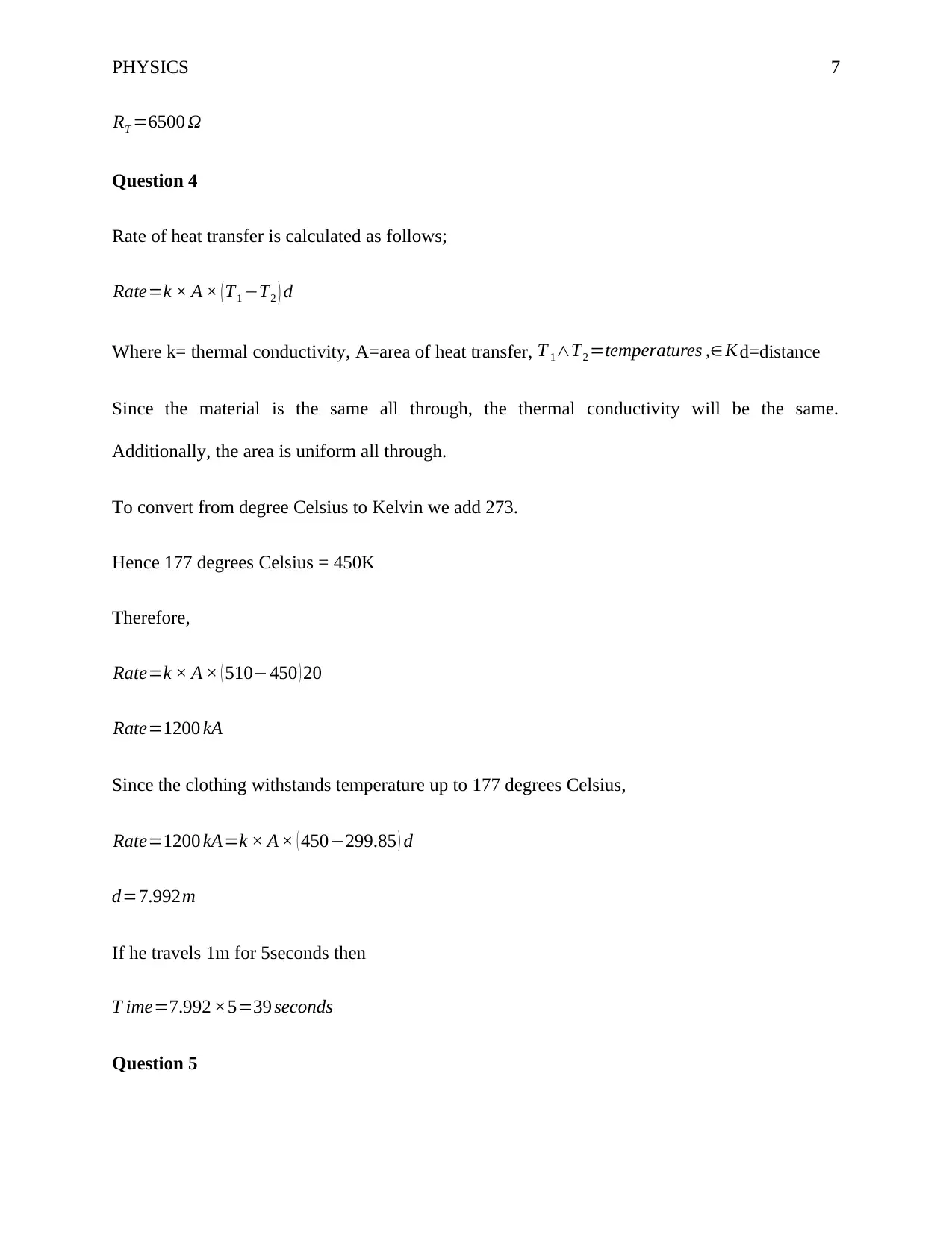
PHYSICS 7
RT =6500 Ω
Question 4
Rate of heat transfer is calculated as follows;
Rate=k × A × ( T1 −T2 ) d
Where k= thermal conductivity, A=area of heat transfer, T 1∧T2 =temperatures ,∈ Kd=distance
Since the material is the same all through, the thermal conductivity will be the same.
Additionally, the area is uniform all through.
To convert from degree Celsius to Kelvin we add 273.
Hence 177 degrees Celsius = 450K
Therefore,
Rate=k × A × ( 510−450 ) 20
Rate=1200 kA
Since the clothing withstands temperature up to 177 degrees Celsius,
Rate=1200 kA=k × A × ( 450−299.85 ) d
d=7.992m
If he travels 1m for 5seconds then
T ime=7.992 ×5=39 seconds
Question 5
RT =6500 Ω
Question 4
Rate of heat transfer is calculated as follows;
Rate=k × A × ( T1 −T2 ) d
Where k= thermal conductivity, A=area of heat transfer, T 1∧T2 =temperatures ,∈ Kd=distance
Since the material is the same all through, the thermal conductivity will be the same.
Additionally, the area is uniform all through.
To convert from degree Celsius to Kelvin we add 273.
Hence 177 degrees Celsius = 450K
Therefore,
Rate=k × A × ( 510−450 ) 20
Rate=1200 kA
Since the clothing withstands temperature up to 177 degrees Celsius,
Rate=1200 kA=k × A × ( 450−299.85 ) d
d=7.992m
If he travels 1m for 5seconds then
T ime=7.992 ×5=39 seconds
Question 5
Paraphrase This Document
Need a fresh take? Get an instant paraphrase of this document with our AI Paraphraser
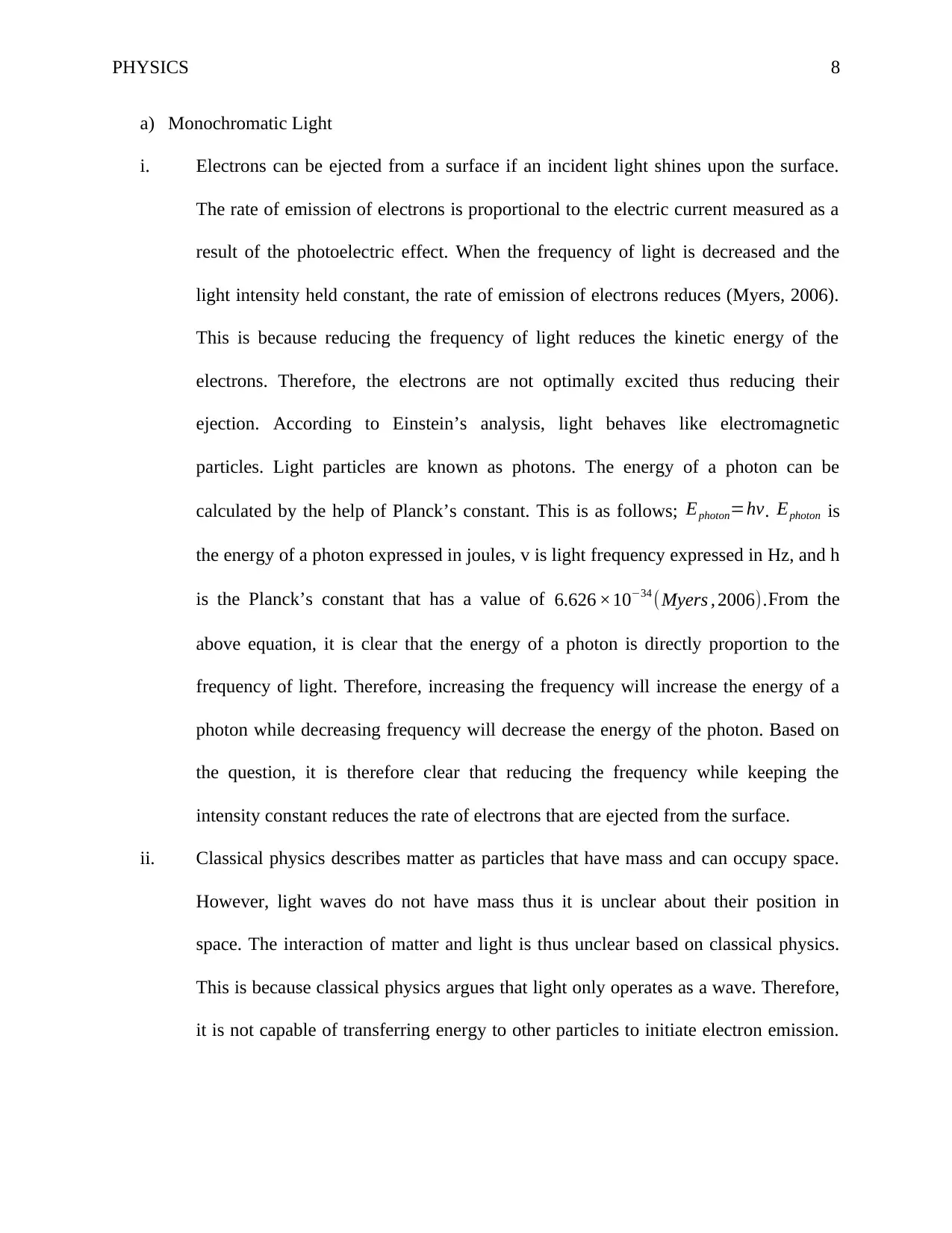
PHYSICS 8
a) Monochromatic Light
i. Electrons can be ejected from a surface if an incident light shines upon the surface.
The rate of emission of electrons is proportional to the electric current measured as a
result of the photoelectric effect. When the frequency of light is decreased and the
light intensity held constant, the rate of emission of electrons reduces (Myers, 2006).
This is because reducing the frequency of light reduces the kinetic energy of the
electrons. Therefore, the electrons are not optimally excited thus reducing their
ejection. According to Einstein’s analysis, light behaves like electromagnetic
particles. Light particles are known as photons. The energy of a photon can be
calculated by the help of Planck’s constant. This is as follows; Ephoton=hv. Ephoton is
the energy of a photon expressed in joules, v is light frequency expressed in Hz, and h
is the Planck’s constant that has a value of 6.626 ×10−34 (Myers , 2006).From the
above equation, it is clear that the energy of a photon is directly proportion to the
frequency of light. Therefore, increasing the frequency will increase the energy of a
photon while decreasing frequency will decrease the energy of the photon. Based on
the question, it is therefore clear that reducing the frequency while keeping the
intensity constant reduces the rate of electrons that are ejected from the surface.
ii. Classical physics describes matter as particles that have mass and can occupy space.
However, light waves do not have mass thus it is unclear about their position in
space. The interaction of matter and light is thus unclear based on classical physics.
This is because classical physics argues that light only operates as a wave. Therefore,
it is not capable of transferring energy to other particles to initiate electron emission.
a) Monochromatic Light
i. Electrons can be ejected from a surface if an incident light shines upon the surface.
The rate of emission of electrons is proportional to the electric current measured as a
result of the photoelectric effect. When the frequency of light is decreased and the
light intensity held constant, the rate of emission of electrons reduces (Myers, 2006).
This is because reducing the frequency of light reduces the kinetic energy of the
electrons. Therefore, the electrons are not optimally excited thus reducing their
ejection. According to Einstein’s analysis, light behaves like electromagnetic
particles. Light particles are known as photons. The energy of a photon can be
calculated by the help of Planck’s constant. This is as follows; Ephoton=hv. Ephoton is
the energy of a photon expressed in joules, v is light frequency expressed in Hz, and h
is the Planck’s constant that has a value of 6.626 ×10−34 (Myers , 2006).From the
above equation, it is clear that the energy of a photon is directly proportion to the
frequency of light. Therefore, increasing the frequency will increase the energy of a
photon while decreasing frequency will decrease the energy of the photon. Based on
the question, it is therefore clear that reducing the frequency while keeping the
intensity constant reduces the rate of electrons that are ejected from the surface.
ii. Classical physics describes matter as particles that have mass and can occupy space.
However, light waves do not have mass thus it is unclear about their position in
space. The interaction of matter and light is thus unclear based on classical physics.
This is because classical physics argues that light only operates as a wave. Therefore,
it is not capable of transferring energy to other particles to initiate electron emission.
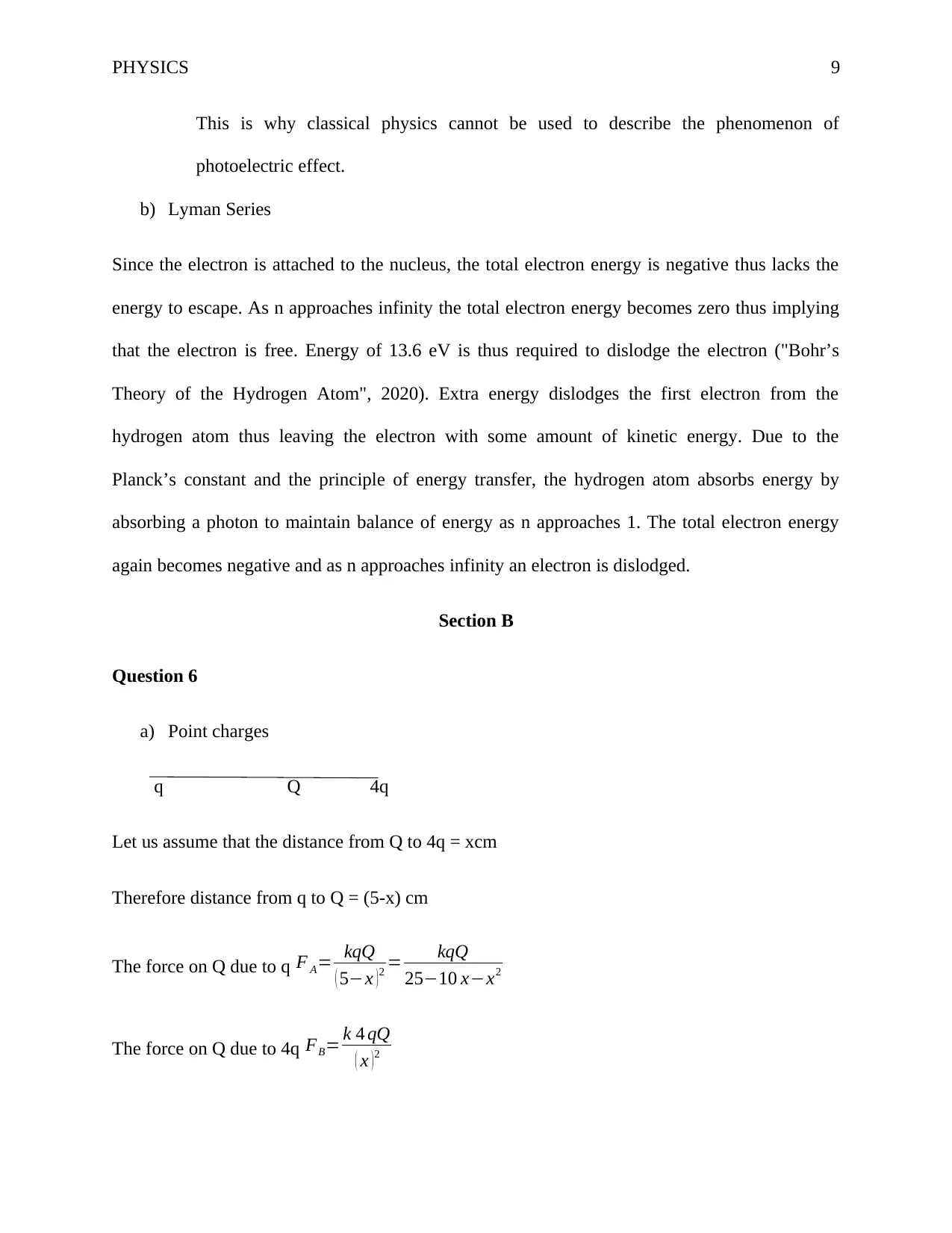
PHYSICS 9
This is why classical physics cannot be used to describe the phenomenon of
photoelectric effect.
b) Lyman Series
Since the electron is attached to the nucleus, the total electron energy is negative thus lacks the
energy to escape. As n approaches infinity the total electron energy becomes zero thus implying
that the electron is free. Energy of 13.6 eV is thus required to dislodge the electron ("Bohr’s
Theory of the Hydrogen Atom", 2020). Extra energy dislodges the first electron from the
hydrogen atom thus leaving the electron with some amount of kinetic energy. Due to the
Planck’s constant and the principle of energy transfer, the hydrogen atom absorbs energy by
absorbing a photon to maintain balance of energy as n approaches 1. The total electron energy
again becomes negative and as n approaches infinity an electron is dislodged.
Section B
Question 6
a) Point charges
q Q 4q
Let us assume that the distance from Q to 4q = xcm
Therefore distance from q to Q = (5-x) cm
The force on Q due to q F A= kqQ
( 5−x )2 = kqQ
25−10 x−x2
The force on Q due to 4q FB= k 4 qQ
( x ) 2
This is why classical physics cannot be used to describe the phenomenon of
photoelectric effect.
b) Lyman Series
Since the electron is attached to the nucleus, the total electron energy is negative thus lacks the
energy to escape. As n approaches infinity the total electron energy becomes zero thus implying
that the electron is free. Energy of 13.6 eV is thus required to dislodge the electron ("Bohr’s
Theory of the Hydrogen Atom", 2020). Extra energy dislodges the first electron from the
hydrogen atom thus leaving the electron with some amount of kinetic energy. Due to the
Planck’s constant and the principle of energy transfer, the hydrogen atom absorbs energy by
absorbing a photon to maintain balance of energy as n approaches 1. The total electron energy
again becomes negative and as n approaches infinity an electron is dislodged.
Section B
Question 6
a) Point charges
q Q 4q
Let us assume that the distance from Q to 4q = xcm
Therefore distance from q to Q = (5-x) cm
The force on Q due to q F A= kqQ
( 5−x )2 = kqQ
25−10 x−x2
The force on Q due to 4q FB= k 4 qQ
( x ) 2
⊘ This is a preview!⊘
Do you want full access?
Subscribe today to unlock all pages.

Trusted by 1+ million students worldwide
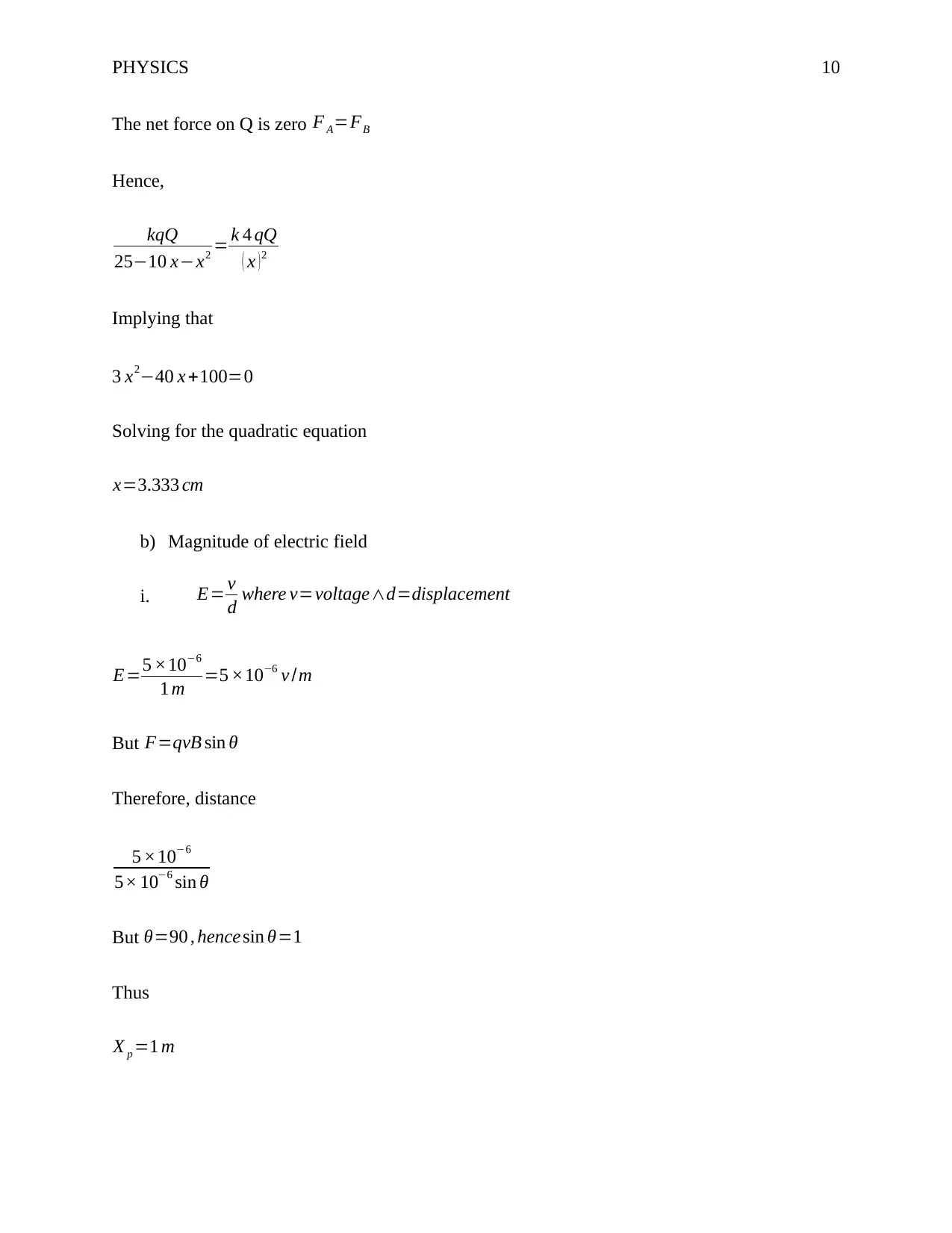
PHYSICS 10
The net force on Q is zero F A=FB
Hence,
kqQ
25−10 x−x2 = k 4 qQ
( x ) 2
Implying that
3 x2−40 x +100=0
Solving for the quadratic equation
x=3.333 cm
b) Magnitude of electric field
i. E= v
d where v=voltage∧d=displacement
E=5 ×10−6
1 m =5 ×10−6 v /m
But F=qvB sin θ
Therefore, distance
5 ×10−6
5× 10−6 sin θ
But θ=90 , hence sin θ=1
Thus
X p =1 m
The net force on Q is zero F A=FB
Hence,
kqQ
25−10 x−x2 = k 4 qQ
( x ) 2
Implying that
3 x2−40 x +100=0
Solving for the quadratic equation
x=3.333 cm
b) Magnitude of electric field
i. E= v
d where v=voltage∧d=displacement
E=5 ×10−6
1 m =5 ×10−6 v /m
But F=qvB sin θ
Therefore, distance
5 ×10−6
5× 10−6 sin θ
But θ=90 , hence sin θ=1
Thus
X p =1 m
Paraphrase This Document
Need a fresh take? Get an instant paraphrase of this document with our AI Paraphraser
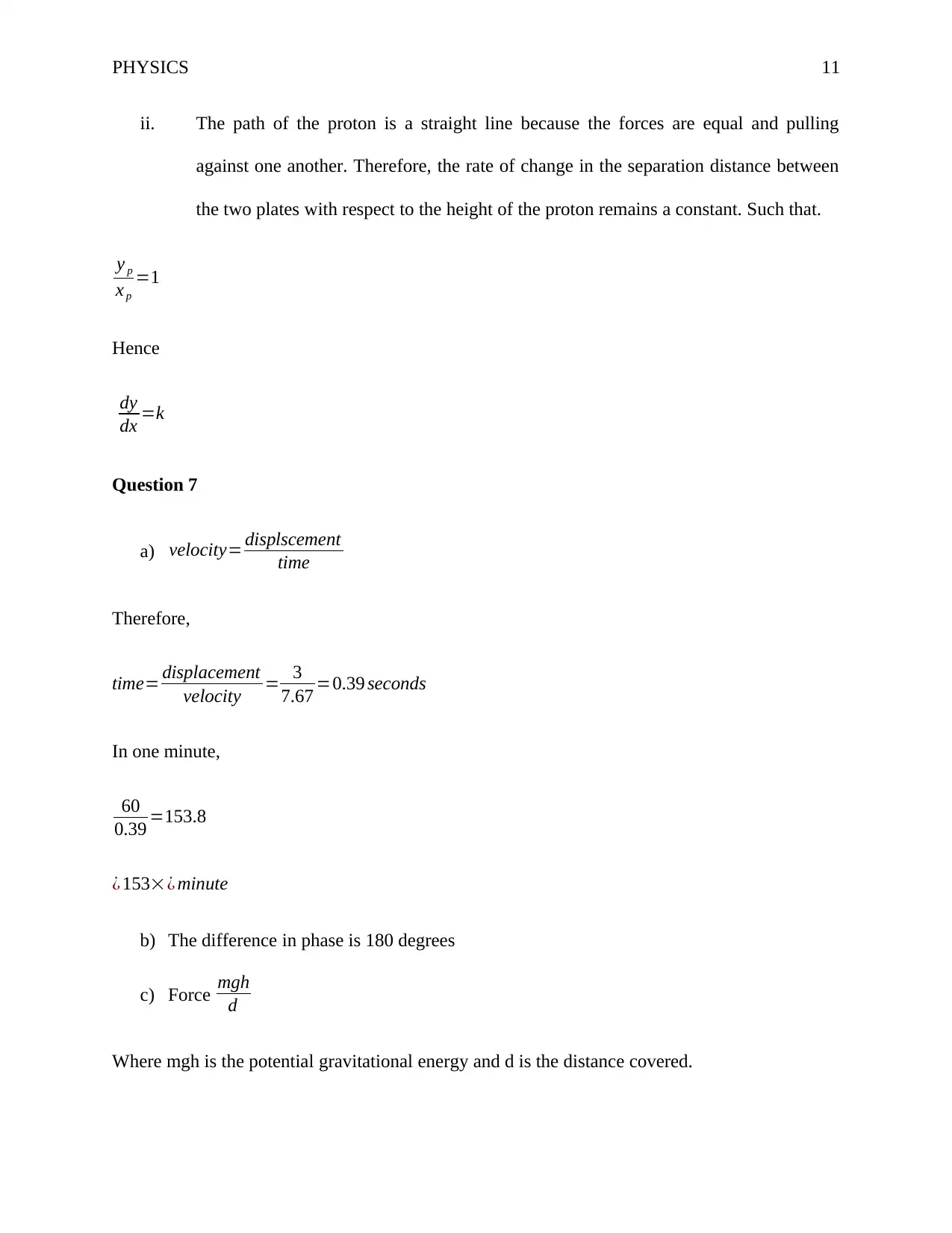
PHYSICS 11
ii. The path of the proton is a straight line because the forces are equal and pulling
against one another. Therefore, the rate of change in the separation distance between
the two plates with respect to the height of the proton remains a constant. Such that.
y p
x p
=1
Hence
dy
dx =k
Question 7
a) velocity= displscement
time
Therefore,
time= displacement
velocity = 3
7.67 =0.39 seconds
In one minute,
60
0.39 =153.8
¿ 153׿ minute
b) The difference in phase is 180 degrees
c) Force mgh
d
Where mgh is the potential gravitational energy and d is the distance covered.
ii. The path of the proton is a straight line because the forces are equal and pulling
against one another. Therefore, the rate of change in the separation distance between
the two plates with respect to the height of the proton remains a constant. Such that.
y p
x p
=1
Hence
dy
dx =k
Question 7
a) velocity= displscement
time
Therefore,
time= displacement
velocity = 3
7.67 =0.39 seconds
In one minute,
60
0.39 =153.8
¿ 153׿ minute
b) The difference in phase is 180 degrees
c) Force mgh
d
Where mgh is the potential gravitational energy and d is the distance covered.
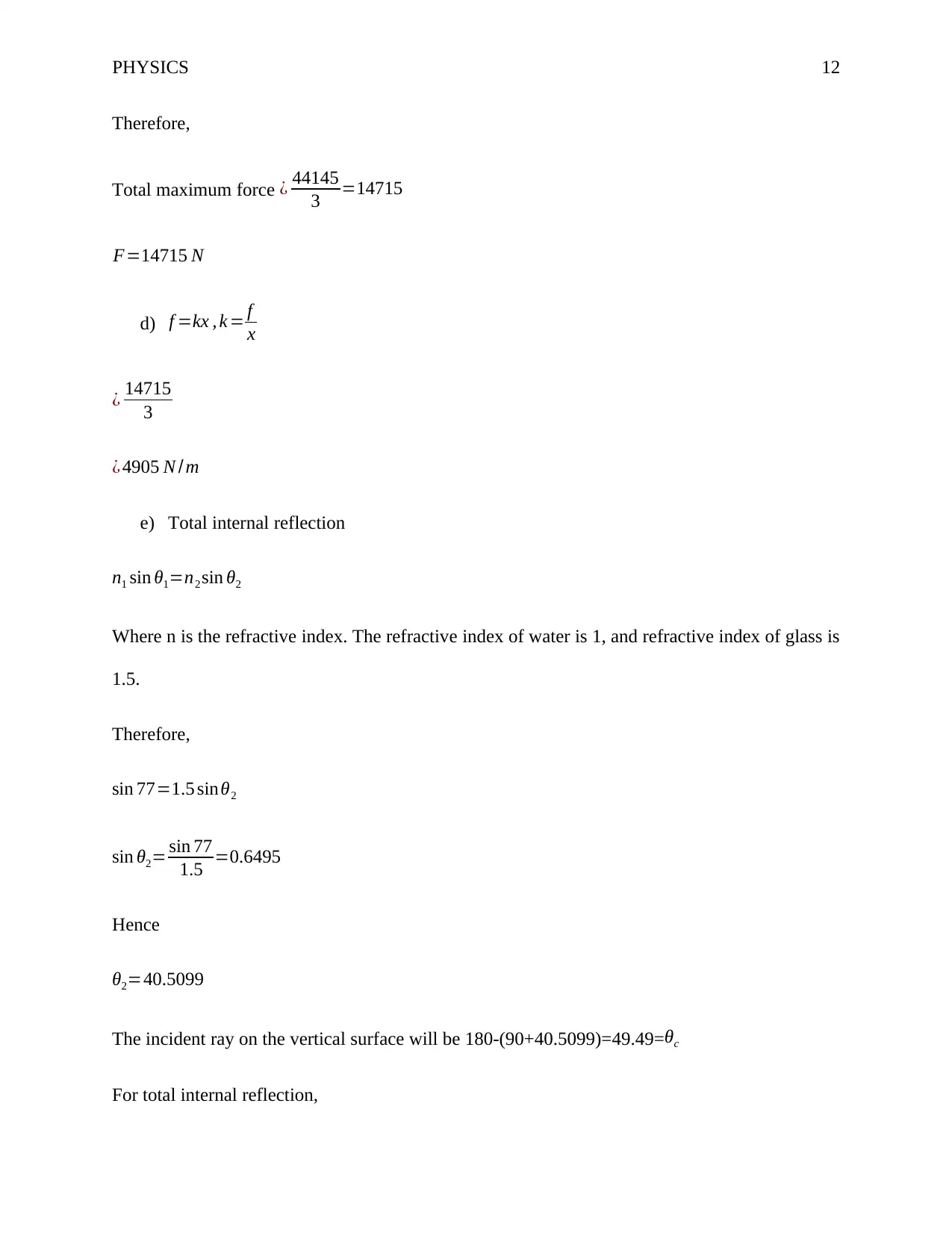
PHYSICS 12
Therefore,
Total maximum force ¿ 44145
3 =14715
F=14715 N
d) f =kx , k = f
x
¿ 14715
3
¿ 4905 N / m
e) Total internal reflection
n1 sin θ1=n2 sin θ2
Where n is the refractive index. The refractive index of water is 1, and refractive index of glass is
1.5.
Therefore,
sin 77=1.5 sinθ2
sin θ2= sin 77
1.5 =0.6495
Hence
θ2=40.5099
The incident ray on the vertical surface will be 180-(90+40.5099)=49.49= θc
For total internal reflection,
Therefore,
Total maximum force ¿ 44145
3 =14715
F=14715 N
d) f =kx , k = f
x
¿ 14715
3
¿ 4905 N / m
e) Total internal reflection
n1 sin θ1=n2 sin θ2
Where n is the refractive index. The refractive index of water is 1, and refractive index of glass is
1.5.
Therefore,
sin 77=1.5 sinθ2
sin θ2= sin 77
1.5 =0.6495
Hence
θ2=40.5099
The incident ray on the vertical surface will be 180-(90+40.5099)=49.49= θc
For total internal reflection,
⊘ This is a preview!⊘
Do you want full access?
Subscribe today to unlock all pages.

Trusted by 1+ million students worldwide
1 out of 16
Your All-in-One AI-Powered Toolkit for Academic Success.
+13062052269
info@desklib.com
Available 24*7 on WhatsApp / Email
![[object Object]](/_next/static/media/star-bottom.7253800d.svg)
Unlock your academic potential
Copyright © 2020–2025 A2Z Services. All Rights Reserved. Developed and managed by ZUCOL.


